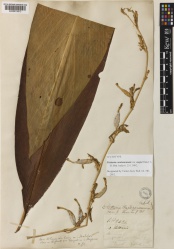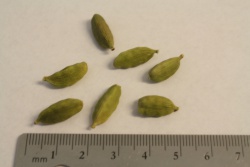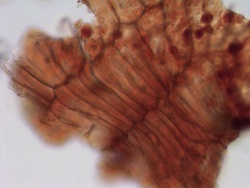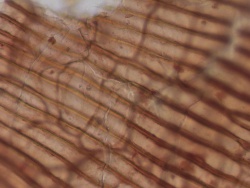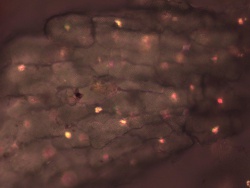| Elettaria cardamomum
The cardamom plant has a tuberous horizontal rhizome, sending up from eight to twenty erect, simple, smooth, green and shining, perennial stems, which rise from six to twelve feet in height, and bear alternate elliptical-lanceolate sheathing leaves. The flower-stalk proceeds from the base of the stem, and lies upon the ground, with the flowers arranged in a panicle. The fruit is a three-celled capsule, containing many seeds; during drying it is said to lose three-fourths of its weight.
"Mostly agglutinated in groups of from 2 to 7, the individual seeds, oblong-ovoid in outline, 3- or irregularly 4-sided, convex on the dorsal surface, strongly longitudinally grooved on one side, from 3 to 4 mm. in length; externally reddish-gray-brown, coarsely tuberculated, and with more or less adhering portions of the membranous aril; in section showing a thin reddish-brown seed-coat, a large white perisperm and a central, greenish endosperm enclosing a small straight embryo. [...]
"Fruits from one to two centimetres long, ovoid or oblong, bluntly triangular in section, shortly beaked at the apex, pale buff in color, plump and nearly smooth or with slight longitudinal striations. Seeds dark reddish-brown, about three millimetres in length and the same in breadth and thickness, irregularly angular, transversely wrinkled, and enclosed in a thin, colorless, membranous aril."
Source: United States Dispensatory (1918) [5]
|
|
|

